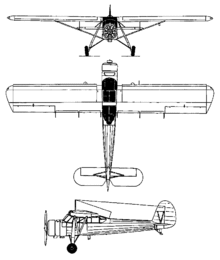| Ki-76 | |
|---|---|

| |
| Role | Liaison/observation |
| Manufacturer | Kokusai |
| First flight | 1941 |
| Introduction | 1942 |
| Retired | 1945 |
| Primary user | Imperial Japanese Army Air Service |
| Number built | 937 including a single prototype |
The Kokusai Ki-76, or Liaison Aircraft Type 3 (in Japanese: 三式指揮連絡機), was a Japanese high-wing monoplane artillery spotter and liaison aircraft that served in World War II. The Allied reporting name was "Stella".
Design and development
In 1940, the Imperial Japanese Army Air Force ordered the Nippon Kokusai Koku Kogyo to produce an artillery spotting and liaison aircraft. The resulting Ki-76 was inspired by, and similar to, the German Fieseler Fi 156 "Storch", although not a direct copy.[1] Like the Storch, it was a high-winged monoplane with a fixed tailwheel undercarriage. However, rather than the slotted flaps used by the German aircraft, the Ki-76 used Fowler flaps, while it was powered by Hitachi Ha-42 radial engine rather than the Argus As 10 inline engine of the Storch.
First flying in May 1941, the Ki-76 proved successful when evaluated against an example of the Fi-156, and was ordered into production as the Army Type 3 Command Liaison Plane in November 1942.[2]
Operational history

The Ki-76 remained in service as an artillery spotter and liaison aircraft until the end of the war. Ki-76s were also used as anti-submarine aircraft, operating from the Japanese Army's escort carrier, the Akitsu Maru, being fitted with an arrestor hook and carrying two 60 kg (132 lb) depth charges.[3]
Operators
Specifications (Ki-76)

Data from Encyclopedia of Military Aircraft,[4] Japanese Aircraft of the Pacific War[5]
General characteristics
- Crew: 2
- Length: 9.65 m (31 ft 8 in)
- Wingspan: 15 m (49 ft 3 in)
- Height: 2.9 m (9 ft 6 in)
- Wing area: 29.4 m2 (316 sq ft)
- Empty weight: 1,110 kg (2,447 lb)
- Gross weight: 1,530 kg (3,373 lb)
- Max takeoff weight: 1,623 kg (3,578 lb)
- Powerplant: 1 × Hitachi Ha42 9-cylinder air-cooled radial piston engine, 231 kW (310 hp)
- Propellers: 2-bladed fixed-pitch propeller
Performance
- Maximum speed: 178 km/h (111 mph, 96 kn) at sea level
- Range: 750 km (470 mi, 400 nmi)
- Service ceiling: 5,630 m (18,470 ft)
Armament
- Guns: 1× 7.7 mm (0.303 in) machine gun in rear cockpit
- Bombs: 2× 60 kg (132 lb) depth charges (some variants)
See also
Aircraft of comparable role, configuration, and era
- Fieseler Fi 156 Storch
- IMAM Ro.63
- Kobeseiko Te-Gō
- Repülőgépgyár Levente II
- Westland Lysander
- Taylorcraft Auster
Related lists
References
- ^ Francillon 1979, p. 147.
- ^ Francillon 1979, p. 148.
- ^ Francillon 1979, pp. 148–149.
- ^ Jackson 2002, p. 224
- ^ Francillon 1979, p. 149
Sources
- Francillon, René J. (1979). Japanese aircraft of the Pacific War. London: Putnam. ISBN 0-370-30251-6. OCLC 6124909. (new edition 1987 by Putnam Aeronautical Books, ISBN 0-85177-801-1.)
- Jackson, Robert (2002). The Encyclopedia of Military Aircraft. Parragon. ISBN 0-7525-8130-9..
